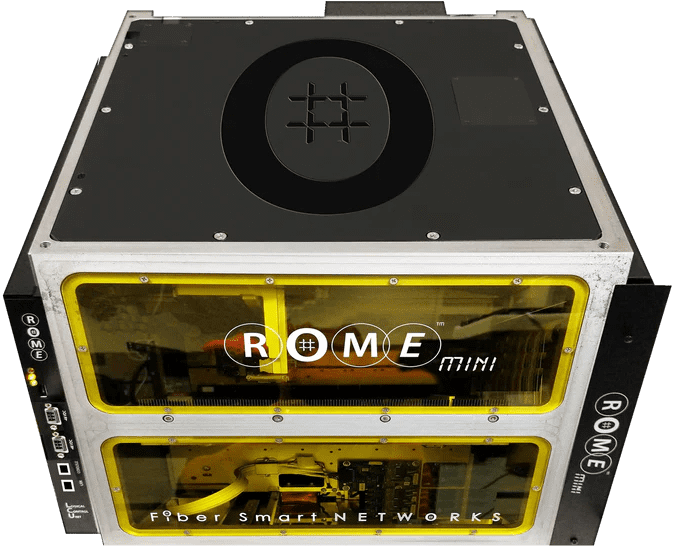In an era where data demands are skyrocketing and network reliability is non-negotiable, FiberSmart’s ROME Mini emerges as a game-changer in the world of fiber optic automation. This compact, robotic fiber switching system—part of the broader Robotic Optical Management Engine (ROME) family—brings intelligence, efficiency, and scalability to the physical layer of network infrastructure. Designed to fit seamlessly into space-constrained environments while managing over 200 fibers in a 7RU (rack unit) footprint, the ROME Mini is a testament to how automation can transform connectivity challenges into opportunities. Let’s dive into what makes this technology stand out and explore the use cases where it shines brightest.
What is ROME Mini?
The ROME Mini is a small-form-factor robotic fiber switch engineered by FiberSmart to automate the physical layer of network connectivity. Housed in a rack-mountable 19-inch frame, it leverages software-directed robots to handle fiber patching with pinpoint accuracy, eliminating the need for manual intervention. With a capacity of over 200 fibers, it supports both single-mode and multi-mode fibers, delivering low insertion loss and protocol-agnostic performance. Its intuitive drag-and-drop graphical interface allows network administrators to reconfigure connections remotely, making it a powerful tool for modern, dynamic networks. Redundant power supplies (AC or DC) ensure uptime, while its compact design caters to environments where every inch of space counts.
This isn’t just a piece of hardware—it’s a paradigm shift. By automating what was once a labor-intensive, error-prone process, ROME Mini slashes operational costs, boosts reliability, and future-proofs networks for emerging technologies. But where does it truly excel? Let’s explore its standout use cases.
Use Cases Where ROME Mini Thrives
- Edge Data Centers: Powering the Edge Revolution
- Why It Fits: Edge computing is exploding as 5G, IoT, and AI-driven applications demand low-latency, localized processing. Edge data centers—often smaller and more distributed than traditional hubs—need efficient, reliable connectivity in tight spaces. ROME Mini’s compact 7RU design and 200+ fiber capacity make it an ideal fit, automating connections without requiring on-site technicians.
- Real-World Impact: Imagine a retail chain deploying edge nodes for real-time inventory tracking across dozens of locations. ROME Mini can instantly reconfigure fiber links to prioritize bandwidth for peak shopping hours, all managed remotely from a central office, reducing downtime and travel costs.
- Benefits: Reduced latency, lower OPEX, and the ability to scale connectivity as edge demands grow.
- 5G Networks: Supporting Next-Gen Mobile Infrastructure
- Why It Fits: 5G’s promise of ultra-fast speeds and massive device connectivity relies on a dense web of fiber backhaul. ROME Mini excels in mobile backhaul facilities and small cell deployments, where space is limited and rapid reconfiguration is key. Its robotic automation ensures flawless fiber management, even in remote or hard-to-access sites.
- Real-World Impact: A telecom provider rolling out 5G in a rural area can use ROME Mini to dynamically adjust fiber connections during a natural disaster, rerouting traffic around damaged cables in seconds rather than days.
- Benefits: Faster service provisioning, enhanced resilience, and support for billions of IoT devices.
- Optical Access Networks: Streamlining Last-Mile Connectivity
- Why It Fits: Optical access networks, like those powering FTTH (Fiber to the Home), require agile, cost-effective solutions to connect end-users. ROME Mini’s ability to manage high fiber counts in a small footprint makes it perfect for central offices or street cabinets, where manual patching is impractical.
- Real-World Impact: A broadband provider can deploy ROME Mini in a neighborhood hub, enabling instant service activation for new subscribers without sending a technician—think gigabit internet activated over a coffee break.
- Benefits: Quicker customer onboarding, fewer truck rolls, and improved service reliability.
- Submarine Cable Landing Stations: Precision in Critical Hubs
- Why It Fits: Subsea cables are the backbone of global internet connectivity, and their landing stations demand flawless fiber management. ROME Mini’s automation and space efficiency shine in these high-stakes environments, where downtime can cost millions.
- Real-World Impact: During a surge in transatlantic traffic, a landing station operator uses ROME Mini to reroute fiber connections in real time, optimizing bandwidth allocation without human intervention.
- Benefits: Minimized downtime, enhanced security (no human errors), and optimized resource use.
- Remote and Unmanned Facilities: Zero-Touch Operations
- Why It Fits: As networks expand into remote or unmanned locations—like rural data centers or battlefield communication hubs—manual maintenance becomes a logistical nightmare. ROME Mini’s remote management and robotic reliability eliminate the need for on-site staff, ensuring uptime in even the toughest conditions.
- Real-World Impact: A military base deploys ROME Mini to maintain a secure fiber network. When a cable fails, the system autonomously reroutes traffic, keeping critical comms online without risking personnel exposure.
- Benefits: Reduced labor costs, heightened security, and uninterrupted service in isolated areas.
- Testing Labs: Accelerating Innovation
- Why It Fits: Network development labs need flexible, rapid reconfiguration to test new topologies or equipment. ROME Mini’s software-driven automation allows engineers to switch fiber connections remotely, speeding up experimentation without disrupting workflows.
- Real-World Impact: A tech firm testing a new AI-driven routing protocol uses ROME Mini to simulate dozens of network layouts in a day, cutting testing timelines from weeks to hours.
- Benefits: Faster R&D cycles, reduced manual errors, and resource efficiency.
Why ROME Mini Stands Out
What sets ROME Mini apart isn’t just its hardware—it’s the vision behind it. By marrying robotics with fiber optics, FiberSmart addresses the long-overlooked bottleneck of physical layer management. Traditional patching is slow, prone to mistakes, and costly; ROME Mini flips that script with speed, precision, and autonomy. Its energy-efficient design (50-150 watts, akin to a light bulb) and long lifespan (3 million cycles) make it a sustainable investment, while its compatibility with SDN (Software-Defined Networking) ensures it integrates seamlessly into modern architectures.
Critics might argue that robotics in networking feels like overkill, but the reality proves otherwise. In a world where downtime equals lost revenue and human error can cripple operations, automation isn’t a luxury—it’s a necessity. ROME Mini delivers that necessity in a package that’s practical, powerful, and perfectly suited to the demands of 2025 and beyond.
The Future of Connectivity
As of February 26, 2025, the ROME Mini from FiberSmart isn’t just keeping pace with network evolution—it’s driving it. From edge data centers to 5G rollouts, optical access to remote operations, this robotic marvel empowers organizations to build smarter, more resilient networks. It’s not about replacing humans; it’s about freeing them to focus on strategy while the robots handle the grunt work. For anyone looking to future-proof their infrastructure, ROME Mini isn’t just a tool—it’s a cornerstone.
Ready to see it in action? FiberSmart offers free design consultations to tailor ROME Mini to your needs. In a world racing toward an AI-driven, hyper-connected future, this is one innovation you can’t afford to overlook.











